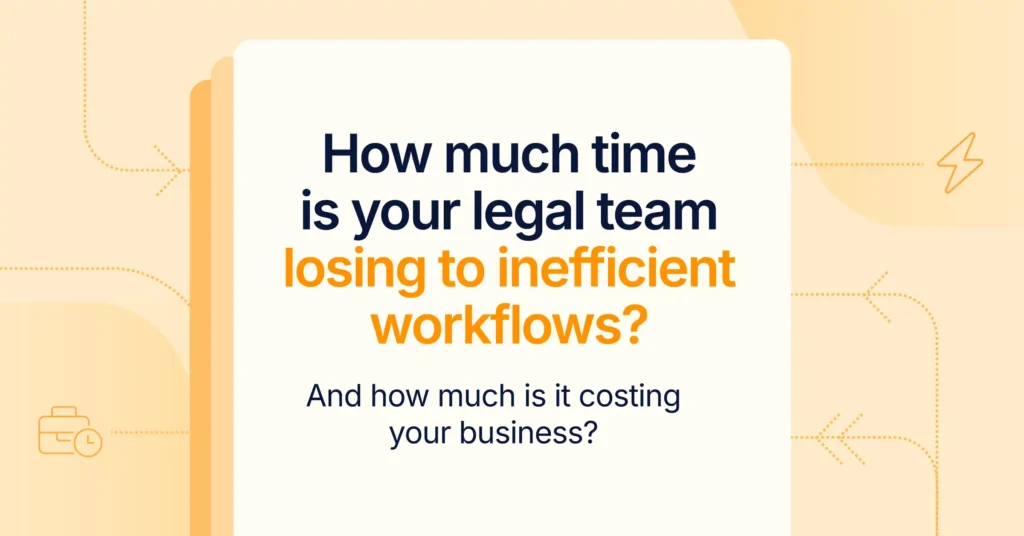The more time spent without in-house legal software, the greater the cost
Legal teams turn to in-house legal software to solve a litany of problems including, but not limited to, saving valuable time for legal team members, creating visibility and continuity with a central repository for legal work, automating and streamlining workflows across the business, speeding up cycle times, reducing risk, scaling legal service, managing costs, creating data sets for better decision making… the list goes on.
However, the prospect of purchasing new in-house legal tech can be daunting: the number and type of solutions available is vast and varied and can be hard to make sense of; many in-house legal teams are pressed for time and resource, making it difficult to find time to evaluate technology solutions; budget pressures and resource constraints can make it difficult to procure budget or feel confident about the return on investment. But the more time you spend without the right legal technology, the more it costs the business:
+
$
How to use this guide
This guide is intended to support you in making buying decisions for in-house legal software best suited to your legal function and the wider business. In doing so, it may not make sense to follow each step sequentially, and that’s ok! The important thing is that these considerations are taken on board as and when you encounter them.
We’ve made sure to include useful tips and resources throughout each step as you progress.
The ultimate goal is for the buying process to move at pace, so you're quickly able to focus on delivering stellar service to the business without it costing your legal function (and business) any more time or money than necessary.
Let’s dive in!
Ready for legal tech but
stuck at a “no”?
Our toolkit + expert consult gets you to “yes”.


Step one: Identify challenges and opportunities within your legal function
Crucial to evaluating legal tech solutions quickly and effectively is clearly identifying your current situation, the pain points and challenges that need solving within your in-house legal team.
It is recommended that you ideate the various ways in which the prospect of new legal technology can address problems for both legal and the business, and express expected outcomes in ways that align with business goals; this will help you to secure funding and support later on and should become part of your business case.
To do this, start by capturing problems, opportunities, and potential outcomes in a format that is both easy to share and interpret. This will make it easier to express the pain points and potential benefits of legal tech to both legal and the business, and to engage stakeholders to get agreement on your investment.
Here’s an example from our free business case template of how you could present this:

Step two: Identify stakeholders and launch your legal tech buying team
Who supports your selection and rollout process? Are you clear on the requirements for securing budget for legal tech if it’s not already approved?
To move at pace with securing new legal tech and to avoid as many roadblocks as possible, you need to know which stakeholders to engage, including those that can help accelerate the process, those that may slow it down, and the specifics each stakeholder is most invested in.
Here are a few stakeholders we think you should consider:
Security/IT
The good news is that many legal tech SaaS vendors have low IT requirements, so you can counter any internal pushback by supplying the IT team with a clear picture of their involvement (or lack thereof). However, you may require sign-off on a security plan, or IT support with implementation and integrations. Here's an example of information you can share with your IT team; partnering with them early and gathering the detail they will need ensures a smooth buying process and better implementation.
Leadership
Getting support from leadership is essential, especially if you do not have budget, as the CFO or similar stakeholders are not likely to allocate technology budget without realizing its importance for legal innovation. Which means it is up to legal to advocate for it. And even if you do have budget allocation for legal tech, it’s a good idea to engage with leadership for their buy-in - this supports a successful rollout across the business.
Tip
Next, it’s time to select your legal tech buying team - and the smaller the team, the faster you will be able to move through the buying process.
In your buying team, consider allocating:
A project lead
The project lead moves things forward, captures critical requirements, communicates with vendors, and is responsible for communicating to your broader group of stakeholders.
A subject matter expert(s)
Subject matter experts are highly interested in sourcing the right legal tech solution and should be present for all demos and product evaluations. They are likely to be your internal champions when it comes to implementing your chosen legal tech solution.
An executive sponsor
An executive sponsor is ultimately the decision maker and is accountable for making the project happen. Often, this is the General Counsel or Chief Legal Officer, but in some organizations you might engage the Chief Technology Officer or Chief Executive Officer.
A business representative(s)
Engaging with a representative who will be a high-frequency business user or stakeholder outside of legal is recommended, as their adoption will be critical to the success of the solution, especially if you are considering a matter management, intake, CLM, or contract automation solution.
Tip
Be sure to schedule and provide updates to your broader group of stakeholders. Offer recorded demos, product videos, and executive summaries to those most interested. Keeping the updates simple but regular will help to mitigate any resistance and can go a long way in supporting change management down the track.
Ready for legal tech but stuck at a “no”?
Our toolkit + expert consult gets you to “yes”.


Step three: Choosing the right technology for your legal tech stack
Choosing the right software for your legal tech stack isn't about ticking boxes - it's about matching tools to your highest-value use cases and solving the most pressing problems efficiently. And since budget and time may not always be available, it pays to think ahead to the next layer of priorities, as you may be able to find technology that will scale with your needs.
Here are some essential tools you might consider for your in-house legal tech stack:
Beyond features, it's important to consider the platform itself - factors like ease of use, onboarding, security, and support can make all the difference between a tool that's successfully adopted and one that gathers dust.
Step four: Evaluating legal tech solutions
The legal tech market is crowded, and it can feel overwhelming. Once you have an idea of what should make up your legal tech stack, explore the solutions that meet your needs and are fit for your requirements. You'll find a few common categories of tools ranging from narrow point solutions to fully integrated legal workspaces.
This video explains the landscape of the legal tech market and how to understand what's on offer. It also unpacks some of the benefits of consolidated platforms versus point solutions:
While each category has pros and cons, only few will give you the benefit of addressing multiple workflows on one unified solution. Here's a simple chart to help compare the options:
It’s also a great time to take advantage of resources such as customer case studies representing organizations similar to yours and review sites such as G2 and Gartner Peer Reviews. Collectively, these resources can also help to narrow your selection criteria and evaluation of the legal tech vendors under consideration.
Step five: Meeting vendors and product demonstrations
Product demonstrations are your chance to see how well a solution addresses your priorities - but they can easily become time-consuming. Focus on making them structured and purposeful.
How to prepare:
What happens after the product demonstration?
Tip
Step six: Make your business case for legal tech
At this stage, you will most likely have one or two legal tech vendors who stand out, but you may still be in the final evaluation stages or need to seek sign-off from certain stakeholders.
If you already have sign-off (great work!), it's time to engage key stakeholders and business partners as you embark on the final steps to purchasing your selected legal tech, most especially with implementation and onboarding pending.
To help gain sign-off and to bring clarity to the next stage of the buying process, a compelling business case is key! You’ll now have an even clearer picture of how your chosen legal tech vendor supports your selection criteria along with key requirements and capabilities, so it’s time to build (or further refine) your business case.
Fortunately, LawVu’s business case template is free to access and fully customizable, so you can tailor it to the unique needs of your legal function and business as well as showcase both qualitative and quantitative evaluations.
Tip
While anecdotal and qualitative information is useful in a business case, it’s always a good idea to include data, metrics, or statistics where you can. For example:
Hopefully, we’ve helped dispel your concerns surrounding the prospect of the legal tech buying journey and have provided you with a clear path forward. Remember, the ultimate goal is to choose the right legal tech for your legal function (and the wider business) and for the buying process to move with pace, as each day you delay is costing your legal function and business time and money.
In no time, you will have influenced key stakeholders with your business case as to why investing in the correct legal tech solution will solve inefficiencies for your team, and your dedicated legal tech buying team will be well on track with implementing your new solution.







